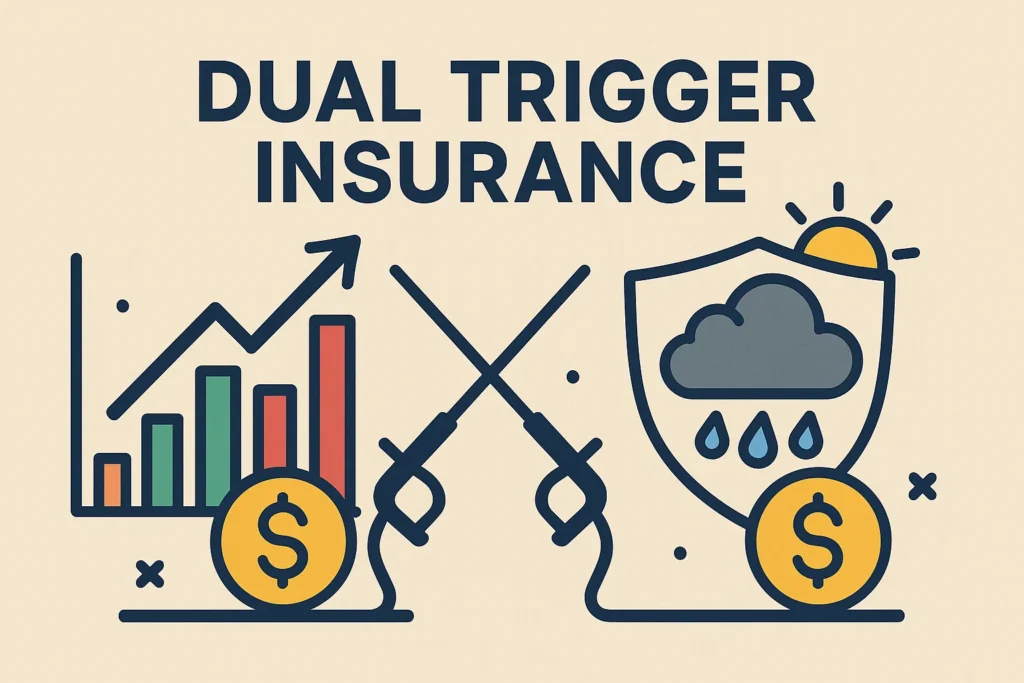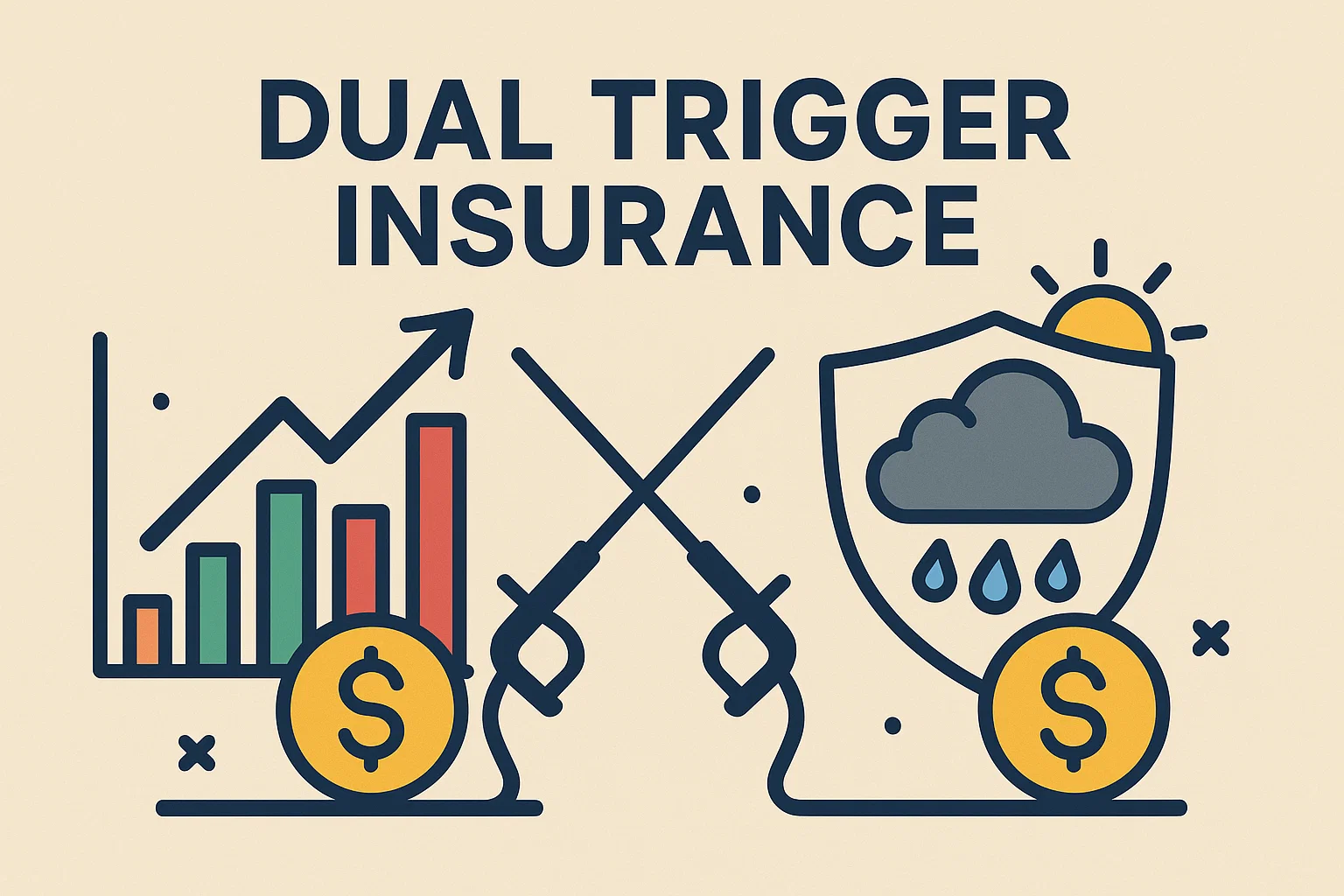
Dual Trigger Insurance: The Smart Shield Against Complex Risks in a Volatile World
In an age marked by increasing unpredictability—be it due to climate change, geopolitical instability, or economic volatility—traditional insurance policies are being stretched to their limits. To bridge the widening gap between actual loss and indemnity, the global insurance sector has birthed innovative solutions. Among the most revolutionary is dual trigger insurance—a bespoke, data-driven financial product designed to provide coverage only when two independent risk events occur.
Dual trigger insurance has steadily grown in popularity among corporations, reinsurers, and risk managers worldwide. Its ability to align insurance payouts with actual business distress—based on both traditional losses and secondary indicators like commodity price drops, interest rate changes, or natural disaster indices—makes it a preferred choice for firms facing multi-dimensional risk.
This article explores the concept of dual trigger insurance globally, outlines the process for obtaining such coverage, identifies the key global players offering these policies, and provides direct links to help you apply or make further inquiries.
Understanding Dual Trigger Insurance
Dual trigger insurance is a type of policy that activates coverage only when two predetermined events occur. Typically, one of these events is a conventional insurable loss (such as property damage or revenue loss), while the other is an external or financial event (like a stock index drop, rainfall deficiency, or price fluctuation).
For example, a food production company might only receive compensation under its dual trigger policy if it suffers crop loss and corn prices fall below a specific threshold.
This structure ensures that payouts happen only when the insured party is most financially vulnerable, which can reduce moral hazard and lower premium costs.
Key Components of Dual Trigger Insurance
- Primary Trigger: A conventional event such as physical damage, business interruption, or supply chain failure.
- Secondary Trigger: Often parametric, such as market indices, weather parameters, or commodity prices.
- Trigger Correlation: Events must be uncorrelated to qualify for dual trigger design; they must be independent for accurate risk modeling.
Global Adoption of Dual Trigger Insurance
While dual trigger insurance originated in the United States in the 1990s, its use has expanded significantly into Europe, Asia, and Latin America due to increasing demand for advanced risk transfer solutions.
- North America: Widely used in the agricultural, energy, and manufacturing sectors.
- Europe: Adopted in financial services, logistics, and climate-sensitive industries.
- Asia-Pacific: Gaining traction in countries with exposure to typhoons, earthquakes, and fluctuating global markets.
- Latin America & Africa: Emerging applications in mining, utilities, and agriculture, supported by microinsurance and global reinsurers.
Benefits of Dual Trigger Insurance
Cost Efficiency: Premiums are often lower than for standard coverage since dual conditions reduce the likelihood of payout.
Tailored Protection: Highly customizable to fit a company’s specific risk profile.
Minimized Moral Hazard: Payouts are tied to both loss and external metrics, discouraging risky behavior.
Balance Sheet Protection: Useful in protecting EBITDA or debt coverage ratios during financial shocks.
Who Should Consider Dual Trigger Insurance?
- Large corporations with complex risk profiles.
- Agribusinesses dependent on weather and commodity prices.
- Energy and mining companies facing both operational and financial risk.
- Financial institutions looking to hedge exposure to macroeconomic indicators.
- Governments and NGOs aiming to protect public infrastructure during crisis events.
The Process to Join or Apply for Dual Trigger Insurance
Securing a dual trigger insurance policy involves a more rigorous and tailored process than standard insurance. Here’s a step-by-step overview:
Risk Assessment
- Conduct an internal audit to identify operational and financial risks.
- Engage a risk manager or actuary to evaluate correlations between potential trigger events.
Data Analysis and Modeling
- Collaborate with insurers or brokers to simulate historical data.
- Define trigger thresholds for both events (e.g., rainfall < 50mm AND crop revenue loss > 30%).
Policy Design
- Customize policy terms, including triggers, payout structures, policy term, and exclusions.
- Ensure regulatory compliance based on jurisdiction.
Quotation and Negotiation
- Approach multiple insurers or reinsurers for quotes.
- Compare premium structures, retention levels, and claims handling procedures.
Purchase and Implementation
- Finalize contract terms.
- Embed the policy within enterprise risk management (ERM) systems.
Monitoring and Claims
- Track real-time data from relevant indices and sources.
- File a claim when both trigger events are verified.
Top Global Providers of Dual Trigger Insurance and How to Apply
Swiss Re
- Overview: One of the world’s largest reinsurers, Swiss Re offers structured risk solutions including dual trigger and parametric coverage.
- How to Apply:
- Visit: https://www.swissre.com
- Navigate to: Corporate Solutions > Alternative Risk Transfer
- Contact a regional office or submit a proposal through the contact form.
Munich Re
- Overview: Munich Re specializes in tailor-made insurance solutions and supports dual trigger structures for weather, natural disaster, and financial risks.
- How to Apply:
- Visit: https://www.munichre.com
- Navigate to: Reinsurance > Customized Solutions
- Use the “Contact Us” portal for consulting and quoting.
AXA XL (a division of AXA Group)
- Overview: AXA XL provides dual trigger insurance via its Alternative Risk Transfer team, serving industrial and commercial sectors.
- How to Apply:
- Visit: https://axaxl.com
- Navigate to: Solutions > Alternative Risk Transfer
- Direct email or online form for proposal submission.
Willis Towers Watson (WTW)
- Overview: A global brokerage firm offering advisory and placement services for dual trigger insurance via captive and parametric teams.
- How to Apply:
- Visit: https://www.wtwco.com
- Navigate to: Solutions > Risk and Broking > Alternative Risk Financing
- Request a consultation or initiate risk modeling support.
Aon
- Overview: Aon offers dual trigger and multi-line insurance coverage through its Reinsurance and Risk Solutions division.
- How to Apply:
- Visit: https://www.aon.com
- Navigate to: Reinsurance Solutions > Innovative Risk Transfer
- Use the site’s contact form or locate a regional expert.
Marsh McLennan
- Overview: Leading broker and consultancy offering structured insurance solutions, including dual triggers for catastrophic risk and financial exposure.
- How to Apply:
- Visit: https://www.marsh.com
- Navigate to: Insurance Services > Alternative Risk Solutions
- Submit a business inquiry or request a custom proposal.
Considerations Before You Apply
- Data Quality: Ensure access to reliable, verifiable data sources for both triggers.
- Independence of Triggers: Ensure that trigger events are not correlated, as this may invalidate the contract or affect pricing.
- Legal Framework: Dual trigger contracts are complex; involve legal counsel for contract interpretation.
- Geographical Jurisdiction: Local insurance regulations may limit use of financial triggers or parametric models.
Dual trigger insurance represents a sophisticated leap in risk management. By bridging traditional loss events with external, measurable indicators, this insurance model provides deeper, more responsive financial protection. Though it requires more diligence in design and application, the benefits far outweigh the complexities for companies operating in high-risk environments.
As global risks become more interdependent and difficult to forecast, dual trigger insurance is poised to become a mainstream tool for protecting businesses across all sectors. Whether you’re a multinational enterprise or a regional agribusiness, now is the time to explore how this innovative solution can future-proof your risk strategy.
